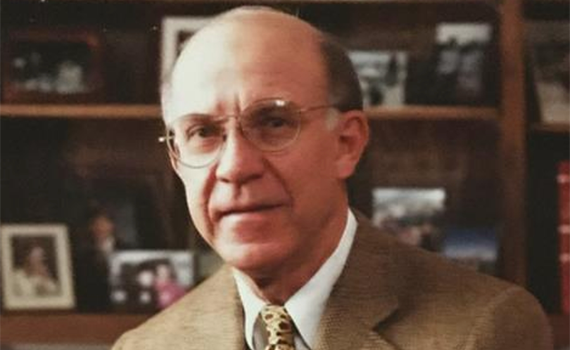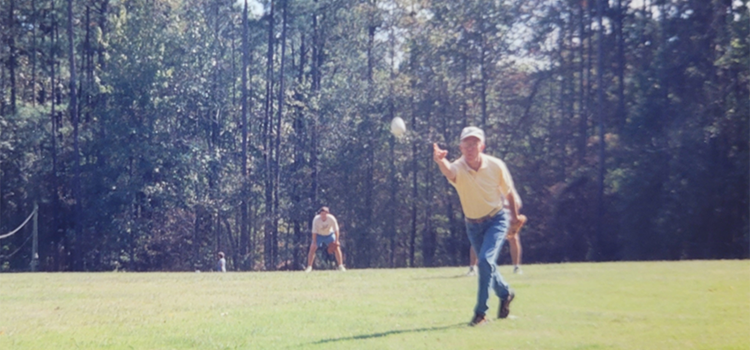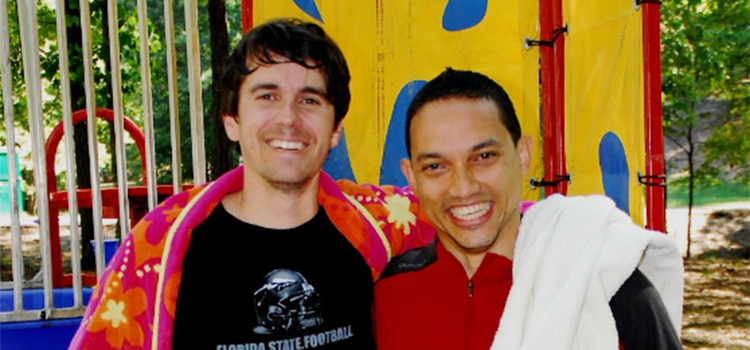 William E. "Bill" Dismukes, M.D., MACPby Dr. Joseph Granade, CMR
William E. "Bill" Dismukes, M.D., MACPby Dr. Joseph Granade, CMR
As the sun set on a deflating bouncy castle and we stowed away the tug-of-war rope for next year, it struck me that it had been, without a doubt, the best Camp Dismukes of my residency. For the past few years, the COVID pandemic had cast a shadow over what was intended to be a fun day for residents to get together and enjoy being outside, far away from the buzzing pagers and beeping monitors of the hospital. As mask restrictions and social distancing recommendations relaxed, we were finally able to get together again this year. We spent the day pumpkin carving with our families, watching fellow residents tumble over each other in the sack race, and simply sitting around talking with friends. The day could not have been better.
As my girlfriend and I left, she asked me who Dismukes was and why the Camp was named after him. At the time I responded with my best guess, which was that he had been a program director for the residency at some point. Being a bit of a nostalgic person, in the following days I found myself wondering who Dr. William E. Dismukes really was and why our residency field day was christened with his name. What follows is my best effort at capturing an oral history of Dr. William E. Dismukes and the Camp Dismukes we UAB residents enjoy today.
William (“Bill”) Dismukes was born on Feb. 18th, 1939 in Montgomery, Alabama. He attended Sidney Lanier High School in Montgomery with his childhood friend, Bill Hinds, who has made a career for himself as a prominent lawyer in Birmingham, where he continues to practice today. Hinds recalls growing up with Dismukes quite fondly. He recounted both his popularity and his penchant for athleticism, especially as point guard for their high school basketball team. He remembered Dismukes spending nearly every summer of his youth at Camp Rotary in Montgomery working as a camp counselor with the 4-H program, which almost certainly played a formative role in his later creation of Camp Dismukes. The two friends’ paths diverged when Dismukes went to Vanderbilt where he continued to play basketball until starting medical school at the University of Alabama where he received the Dean’s Medal upon graduation in 1964. He then traveled to Brigham and Women’s Hospital in Boston to complete his residency. At that time most men were required to complete a service requirement with the US government, which he satisfied by working as an epidemic intelligence service (EIS) officer for the Center for Disease Control in Atlanta. This position would come to serve as the foundation of his research career. It was while attending a medical conference in Atlantic City that Dismukes happened to cross paths with Glenn Cobbs, MD, who had established the Division of Infectious Diseases at UAB only three years prior in 1968. Cobbs recounted the causal nature of the interaction during our interview. Dismukes said he missed Birmingham and asked if there might be a place for him at UAB. Being Harvard-trained and an Alabama-native, Dismukes was a natural addition to the growing division, which also included Kirk Avent, MD, who joined the prior year. Cobbs said he’d be happy to have him, and the rest is history as they say. At that time Tinsley Harrison was still actively involved as an educator at UAB and Cobbs, Dismukes, and Avent each worked as attendings alongside him during their early years on faculty. Over the next decade, the three men would go on to establish the UAB Infection Disease division as we know it today, which included mentorship and recruitment of prominent physicians such as Peter Pappas and Mike Saag, who would one day co-author Dismukes’ obituary featured in The Journal of Infectious Diseases.
During my interview with Dr. Cobbs, he spoke highly of Dismukes. “[He] was bright and ambitious. He was the kind of guy who wanted to get better and better every day. We taught each other and learned from each other the way only close colleagues do.” A large aspect of Dismukes’ career was rooted in his research pursuits, which eventually took form in 1978 when he was awarded a contract with the National Institute of Health (NIH) to become the principal investigator of the Mycosis Study Group. The organization’s purpose was to perform multicenter collaborative clinical trials for the prevention and treatment of invasive fungal infections. The group represented one of the first collaborations between academics and government agencies and would go on to successfully conduct over forty clinical trials in mycology. These trials would establish the basis of much of our current understanding of antifungal therapy. His success in furthering infectious disease research would not go unnoticed as in 1990 he would be appointed as the second division director for the department following Dr. Cobb’s transition to the role of Chief of Medicine at the VA. Dismukes would retain the position of ID division director until his retirement in 2007.
While Dismukes was busy serving as a clinician and innovative investigator, he somehow found time to also make his mark on the program as an educator and academic administrator. In the late 1970s, the medicine program at UAB was growing fast and that growth would require organization and administration. In 1978, Tom James, the Chairman of the Department of Medicine at the time, offered William MacLean the nascent role of program director only a few months after completing his cardiology fellowship here at UAB. I was able to speak with Dr. MacLean, who still practices cardiology at Grandview Hospital here in Birmingham, about his time as program director. According to MacLean, the position was not well-defined in those days and largely consisted of compiling schedules for house staff; a task that now resides with the chief residents. Holding the position for only two years before transitioning back into a role more focused on clinical duties, he felt the position would be better suited to someone with an interest in administration. Shortly after the position would be offered to Dismukes.
During the majority of Dismukes’ twenty-year tenure as program director, Dr. John Kennedy served as his associate program director, and, fortunately, he remains on faculty to this day with the Division of Pulmonary Diseases and Critical Care Medicine. According to Kennedy, “the program director didn’t play a vibrant role in the resident’s lives before Bill (referring to Dismukes); Bill saw the value of the position and elevated its importance to what it is today.” When asked about what types of initiatives and challenges the program experienced under their leadership, Kennedy recounted the impact of the Libby Zion case as the catalyst for significant changes to residency training throughout the nation. The 1984 New York State case revolved around the tragic death of an eighteen-year-old woman under the care of an allegedly overworked and under-supervised intern physician. The case provoked decades of progressive external regulation, which would transform the landscape of medical education and resident working conditions for the better. In Kennedy’s words, “Bill saw how the Libby Zion case reflected on medical training at that time and he responded adaptively. He viewed residents as more than simply a workforce, but instead an opportunity to foster the next generation of physicians.” Dismukes and Kennedy shepherded the program through years, marked by the growing pains of increasing regulation and burgeoning administrative requirements in medical education. Resident work hour restrictions and improved call schedules were introduced as the culture of medical education gradually shifted from labor-centric to learner-based under Dismukes’ leadership. While reminiscing, Cobbs described Dismukes as “an extraordinarily effective administrator” and Kennedy jokingly remarked that while empowering those around him, “he wasn’t one to ever fully delegate anything.” He may have struggled at times to delegate because he was so incredibly driven to see things done right. “The mindset was always preparing residents to be good clinicians, but Dismukes wanted more, he wanted to bring in the very best people possible and train them under a banner of academic excellence,” Kennedy told me. One of his principal aims during his time as director was the intentional recruitment of women and minorities. Being an Alabama native himself, he saw this initiative as an essential component of the cultural growth required if they were ever going to have a chance at overcoming local history. In addition to his accomplishments in expanding the diversity of the program, Dismukes also recognized the dire state of primary care in Alabama at that time. He organized the inception of the Med-Peds program as a means to buttress primary care in the state. There were few if any formally trained Med-Peds faculty in the early 1990s, which meant Dismukes would need to arrange for two directors to build the program in concert. Ray Watts, a pediatrician now serving as the chair of pediatrics at Tulane, and John Kennedy, a medicine trained physician who already had administrative experience as the associate program director, would do just that until Dean Miner would eventually assume the position as the first formal Med-Peds director at UAB. As each of my interviews came to a close, I began to understand just how much Dr. Dismukes had accomplished during his twenty years as program director and how so much of my residency experience had been shaped by this man I never met.
Still, none of these many accomplishments explained how our resident field day came to be, and so my search continued. I found that during his time at UAB, Dismukes was awarded more educational awards than could feasibly be listed in the context of this article, but the long list speaks to how admired and respected he was by his residents. One reason he was so beloved was the empathy and compassion he had for his residents. Acknowledging the hard work and long hours they spent in service to their patients, in the fall of 1984 he arranged a half day off for residents to enjoy a softball game together. Already having ties to the 4-H program from his younger years, he organized the event at the 4-H Center at Lay Lake roughly an hour outside of Birmingham. Over the years to follow, the half-day would eventually grow into an overnight event. Fellows from across nearly every specialty of medicine began volunteering their time to provide coverage to allow residents to attend the camp. Dismukes provided food and drinks for the entire day and organized softball games each year that would last the whole afternoon. Residents would then be free to enjoy sharing stories together by the campfire until they turned into their cabins that looked out over the lake. At some point along the way, residents began setting aside time during these camps to voice concerns about the program. These sessions served as the primordial ancestor to the regular Town Hall sessions we have today, wherein residents are given the floor to bring new ideas and concerns to the program administration in a safe environment. Often, senior residents would organize fire-side chats to pass on hard-earned lessons to their younger colleagues; this aspect of the camp experience would later be transformed into a separate event known as the PGY-2 retreat. Dr. Kennedy wasn’t certain exactly when the camp was formally named after Dismukes, but vividly recalled the residents playfully referring to it as “Camp Dismukes” since its early days. “The camp was the first concrete recognition that the residents worked too hard and needed a break, and Dismukes was loved for that,” Kennedy said. The event is now held at Oak Mountain State Park after a mysterious, if not apocryphal, incident that took place around 1996 involving a resident submerging a golf cart into Lay Lake. The camp is also no longer an overnight event, but, as with all traditions, it has changed throughout the years and will continue to evolve with each resident class enjoying their own unique day, all thanks to Dr. Dismukes.
I will end with a quote by one of Dismukes’ last chief residents who went on to do great things of their own:
He was my program director, and I will forever be grateful that I was one of his chief residents. He was a role model to all, and he shaped the professional and personal lives of so many of us.
- Lisa Willett, M.D., Program Director of the Tinsley Harrison Internal Medicine Residency Program, 2012-2022
 Camp Dismukes, October 2022
Camp Dismukes, October 2022
In memory of William E. Dismukes, M.D., MACP (1939-2017, age 78)
I want to give a special thanks to all the friends and colleagues of Dr. Dismukes who offered both their time and their stories to help create this article. I also want to thank the many fellows who have volunteered their time over the years to allow residents to continue to participate in this tradition.
Contributors: John Kennedy, Jr., M.D., Professor Emeritus; C. Glenn Cobbs, M.D., Professor Emeritus; William MacLean, M.D.; Bill Heindz, J.D.
 Dismukes pitching one of the original resident softball games at the 4H Camp, exact year unknown
Dismukes pitching one of the original resident softball games at the 4H Camp, exact year unknown
 Drs. David Fettig and James Willig
Drs. David Fettig and James Willig
as residents emerging from the Camp Dismukes dunk tank in 2011